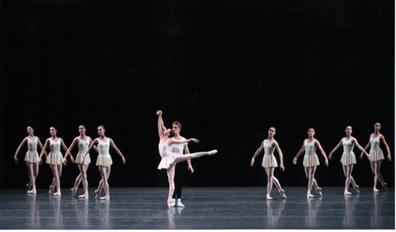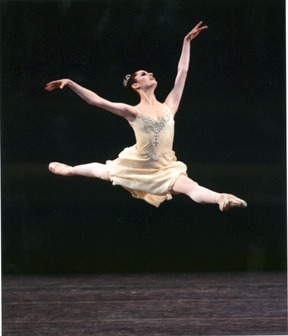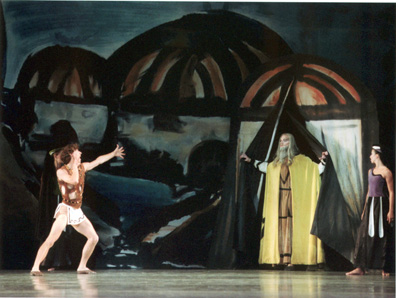Concerto
Barocco, Prodigal Son, Tschaikovsky Piano Concerto No. 2
New York City Ballet
Opera House, Kennedy Center for the Performing Arts
Washington, DC
Thursday, March 4, 2004
by
George Jackson
copyright © 2004 by George Jackson
published 4 March 2004
 Concerto
Barocco has kept its name from its 1941 premiere to the present,
whereas Ballet Imperial, danced for the first time just two days
earlier, was renamed in 1973 for its composer (Tchaikovsky) and musical
score (Piano Concerto No. 2). In all likelihood the foremost reason is
that both ballets were developed principally from musical ideas, and Concerto
Barocco already had a name that gave music its due. Proper credit
seems to have become ever more a priority for George Balanchine, the choreographer
of all 3 works on this second Washington program by New York City Ballet
and, indeed, of all the ballets on the 3 programs danced during this one
week visit.
Concerto
Barocco has kept its name from its 1941 premiere to the present,
whereas Ballet Imperial, danced for the first time just two days
earlier, was renamed in 1973 for its composer (Tchaikovsky) and musical
score (Piano Concerto No. 2). In all likelihood the foremost reason is
that both ballets were developed principally from musical ideas, and Concerto
Barocco already had a name that gave music its due. Proper credit
seems to have become ever more a priority for George Balanchine, the choreographer
of all 3 works on this second Washington program by New York City Ballet
and, indeed, of all the ballets on the 3 programs danced during this one
week visit.
Perhaps other reasons for retaining the Concerto Barocco title
are its metrics and lilt. The syllables convey the baroque propulsiveness
of J.S. Bach's Double Violin Concerto in D Minor and rhymed, the two words
have the ring of latter day syncopation. To give the ballet its full value,
it has to be danced with both Bach's era and 20th Century jazz in mind.
Thursday's performances by the chamber-size female corps de ballet was
properly strong and fleet enough, but it was square. A trait of the Balanchine
dancer I found missing was that about-to-be-in-motion appearance even
before starting to move. These 8 women aroused no expectation. And, once
in motion they didn't call to life this work's delicious tension between
freedom and control.
The dancers in the three leading roles gave a better account of the lean
choreography's riches. Nikolaj Hübbe, as the cast's sole male, does
no substantial solo dancing. His partnering, though, conveyed the feeling
of how a danseur moves. There was gallantry in the way he offered his
lady support— lifting, leading or launching her and then allowing
her to skim freely. Hübbe's reverence was musical and meaningful,
there was a spring to his step and a stability too. Yvonne Borree, dancing
as "first violin", molded her adagio passages in a pleasingly
mellow way and, modestly, rose to the challenge of Pascale van Kipnis'
bright "second violin". Borree had moments on Thursday when
she seemed tight around the shoulders and set her lips tensely; Van Kipnis'
shine might be more effective if it were less uniform. The music was conducted
at a fast clip by NYCB's Hugo Fiorato, with the Kennedy Center Opera House
Orchestra's Oleg Rylatko and Eric Lee as solo violinists.
 What used to be Ballet Imperial has changed over the years, and
history must thank or blame Balanchine who made most of the changes or,
at least, instigated them. There used to be a conversation between the
ballet's ballerina/czarina and the danseur/prince who comes to her court.
It was in pantomime, and this passage happened as a surprise in a work
that, overall, had only dramatic indications but no other specific inicident.
The pantomime was replaced by a danced duo in 1950. Still later, although
the mime was not restored, additional indications gave the entire work
a more consistent mood. Another sort of change, though, happened. I still
find it drastic—replacement of the women's costuming, which had
been the steadfast tutu, by flimsy, loose shifts. The current ones, by
Gary Lisz, are in barely distinguishable pastels—pink, yellow, blue,
lavender and what not. The choreography, though, is based on the very
principles of symmetry, clarity and assurance that prompted the evolution
of the short, imperturbable tutu. No matter how brilliant the cast, these
costumes disfigure the dancing for me.
What used to be Ballet Imperial has changed over the years, and
history must thank or blame Balanchine who made most of the changes or,
at least, instigated them. There used to be a conversation between the
ballet's ballerina/czarina and the danseur/prince who comes to her court.
It was in pantomime, and this passage happened as a surprise in a work
that, overall, had only dramatic indications but no other specific inicident.
The pantomime was replaced by a danced duo in 1950. Still later, although
the mime was not restored, additional indications gave the entire work
a more consistent mood. Another sort of change, though, happened. I still
find it drastic—replacement of the women's costuming, which had
been the steadfast tutu, by flimsy, loose shifts. The current ones, by
Gary Lisz, are in barely distinguishable pastels—pink, yellow, blue,
lavender and what not. The choreography, though, is based on the very
principles of symmetry, clarity and assurance that prompted the evolution
of the short, imperturbable tutu. No matter how brilliant the cast, these
costumes disfigure the dancing for me.
Miranda Weese and Charles Askegard were Thursday's leads. Her taqueté
in the demanding czarina role was deft, admirably so. That her line isn't
ample bothered me at first. Askegard was very much a Yankee at the imperial
court. Ashley Bouder, as the second ballerina—perhaps the czarina's
little sister—and her two swains, Seth Orza and Sean Suozzi, burst
onto the scene like a trio of fighter planes for a display. On the ground,
though, Bouder can be blunt. Maurice Kaplow conducted, with Susan Walters
as the solo pianist.
Prodigal Son, Program #2's midpiece, has an earthy literary lineage—Kochno
going back to basics in the footsteps of Pushkin and the Bible. Pictorial
values are important, too. There are Rouault's actual sets with strokes
of black paint imitating the metal skeletons of stained glass windows
(the sets need other frames on stage than the black curtaining that seems
to have become standard). There are the apt costumes. Balanchine, it seems,
was also thinking of Russian icons. A Renaissance canvas of the becloaked
Father lifting the returned Prodigal into his arms prompted the moment
of final resolution. These are precedents for the choreography as much
as Prokofiev's music. Prodigal Son emerged expressionist and
constructivist. Balanchine built it, like Fokine did Petrouchka,
with ingredients from character dance, ballet and human behavior. Today
it looks bold, in 1929 it should have bowled people over.
 Different
ways of performing the crucial title role are valid. Damian Woetzel, on
Thursday, was direct in his anger, lust, victimization and contrition.
He expressed one emotion at a time simply, powerfully. There wasn't even
a hint of sentimentality in his homecoming. Woetzel's dancing, needless
to say, was strong. The ballet took shape as a portrait of the Prodigal,
with everyone else there just to define his features. That singular focus
was effective. It gave the parable punch.
Different
ways of performing the crucial title role are valid. Damian Woetzel, on
Thursday, was direct in his anger, lust, victimization and contrition.
He expressed one emotion at a time simply, powerfully. There wasn't even
a hint of sentimentality in his homecoming. Woetzel's dancing, needless
to say, was strong. The ballet took shape as a portrait of the Prodigal,
with everyone else there just to define his features. That singular focus
was effective. It gave the parable punch.
As the Siren, it was Maria Kowroski of the splendid, long body opposite
Woetzel. The role's dancing and acrobatics come to her easily, but there
were times when her characterization vanished. The male corps took to
the grotesque behavior of the Prodigal's Drinking Companions with gusto,
while Antonio Carmena and Kyle Froman showed clearly the servants' slippage.
These two men start out no wiser than their prodigal master but turn into
predators. Kaplow conducted vigorously.
This NYCB triple bill was well chosen in significant ways—musically,
visually, temperamentally. Program building in ballet everywhere is a
virtue that's becoming harder to find each season.
Other
NYCB in DC reviews:
Opening night triple bill,
March 3, 2004, by Alexandra Tomalonis
Jewels,
March 5, 2004, by Alexandra Tomalonis
The Great American Dancer,
March 6 (matinee) by Alexandra Tomalonis
NYCB in DC; Last Look and Look
Back, March 7 (matinee and evening) by George Jackson
To read our coverage of the New York Season, click here; you'll be taken to the last review in the series, with links at the bottom of the page to the other reviews.
To read a series of articles by Leigh Witchel on the George Balanchine Foundation's Interpreters Archive Project sessions, in which the creators of many of Balanchine's leading roles coach young dancers in those roles, click here.
Photos, by
Paul Kolnik:
First: Yvonne Borree, Nikolaj Hubbe and the corps de ballet in Concerto
Barocco.
Second: Miranda Weese in Tschaikovsky Piano Concerto
No. 2.
Third: Damian Woetzel in The Prodigal Son.
Originally
published:
www.danceviewtimes.com
Volume 2, Number 9
March 4, 2004
copyright
© 2004 Alexandra
Tomalonis
|
|